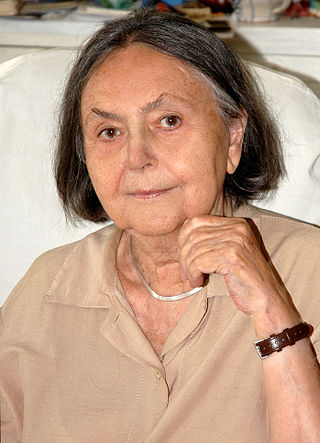Related Research Articles

Ostrava is a city in the north-east of the Czech Republic and the capital of the Moravian-Silesian Region. It has about 280,000 inhabitants. It lies 15 km (9 mi) from the border with Poland, at the confluences of four rivers: Oder, Opava, Ostravice and Lučina. Ostrava is the third largest city in the Czech Republic in terms of both population and area, the second largest city in the region of Moravia, and the largest city in the historical land of Czech Silesia. It straddles the border of the two historic provinces of Moravia and Silesia. The wider conurbation – which also includes the towns of Bohumín, Havířov, Karviná, Orlová, Petřvald and Rychvald – is home to about 500,000 people, making it the largest urban area in the Czech Republic apart from the capital Prague.

Josef Pleskot is a Czech architect. He is known mainly as the designer of the pedestrian tunnel in the Deer Moat at the Prague Castle, and administrative building of the ČSOB in Prague. In 2009, he was voted the most significant Czech architect of the 1989-2009 period.

Ladislav Žák was a Czech architect, painter, architectural theorist and teacher. He was an important exponent of the Czech functionalist architecture in the 1930s, later he devoted himself mainly to landscape architecture. In his theoretical works, he laid the foundations of the Czech landscape ecology.

Viktor Kolář is a Czech photographer. Kolář, along with Jindřich Štreit, is considered one of the most important exponents of Czech documentary photography. In his works, Kolář focuses mainly on depicting urban life in the Ostrava region.

Jaroslav Beneš is a Czech photographer and co-founder of the photographic group called Český dřevák.
The Olomouc language island was a German-speaking area within the Czech-speaking area of central Moravia. It centered on the city of Olomouc, including the city centre, south and west suburbs and several villages on the south and the west. These areas also hosted Czech communities. The Olomouc language island ceased to exist after the expulsion of Germans from Czechoslovakia in 1945 and 1946.

Tomasz Urbanowicz is an architect and a designer of architectural glass art.
Milan Pitlach was a Czech architect and photographer.
Marie Frommer, was a Polish-born German architect. Her work reflected the principles of Expressionism and the Neue Sachlichkeit, emphasizing colour and experimenting with light and form.

Ing. arch. Dr. Jaroslav Otruba was a Czech architect, urban planner, designer and artist.

František Zelenka was a Czech functionalist architect, graphic, stage and costume designer.

Romana Rotterová was a Czech printmaker, sculptor, textile artist, illustrator, and poet.

Czech architecture, or more precisely architecture of the Czech Republic or architecture of Czechia, is a term covering many important historical and contemporary architectural movements in Bohemia, Moravia, and Silesia. From its early beginnings to the present day, almost all historical styles are represented, including many monuments from various historical periods. Some of them are UNESCO World Heritage Sites.

Czech Art Deco, Legiobank style, National style, National decorativeness, Curved Cubism, Rondocubism or Third Cubist style is a series of terms used to describe the characteristic style of architecture and applied arts, which existed mainly during the First Czechoslovak Republic. In the beginning, this particular style was completely neglected. Some rehabilitation has taken place since the 1950s. In the 1990s, attempts were made to place this specifically Czech style in the context of European Art Deco.
Zygmunt Świechowski was a Polish art historian and architectural conservator with a particular interest in the Romanesque era. Świechowski was also a leading figure in architectural preservation and restoration work in Poland, and he used photography extensively to illustrate his books as well as in a number of public exhibitions. His best-known work is Romanesque Art in Poland, with 28 editions published between 1982 and 1990 in six languages.

Jan Fišer is a Czech architect, designer, and university professor.

Václav Aulický is a Czech architect and university professor. He is a graduate of the Faculty of Civil Engineering of the Czech Technical University in Prague. His buildings have hi-tech and postmodern elements.

Martin Rajniš is a Czech architect, urbanist and professor. His architecture design career spans over fifty years and he taught at Academy of Arts, Architecture and Design in Prague from 1990 a 1997 and later at the Technical University of Liberec. He designed high-tech buildings in the 1980s and 1990s, and since 2000, he shifted the materiality and aesthetics of his designs from steel and concrete to "naturalistic" wood, stone and glass, resulting in a number of experimental and organically shaped structures. Rajniš is critical of engineered communist-era architecture, especially concrete tower blocks.
Slovak National Uprising Square is a public square in Ostrava, Czech Republic. The square is located in Ostrava-Jih, the most populous district of the Moravian-Silesian metropole. Developed over the course of the 1950s, it is currently named after one of the most important historical events in Slovak history, the Slovak National Uprising (Czech: Slovenské národní povstání, Slovak: Slovenské národné povstanie).

Josef Danda was a Czech architect. He was a specialist in railway construction and one of the authors of the Praha hlavní nádraží, the most important railway station in the Czech Republic.
References
- ↑ "Kabinet architektury, z. s. | Kabinet architektury". Kabinetarchitektury.cz. 2013-09-15. Retrieved 2017-04-09.
- ↑ icam. "Kabinet architektury – icam". Icam-web.org. Retrieved 2017-04-09.